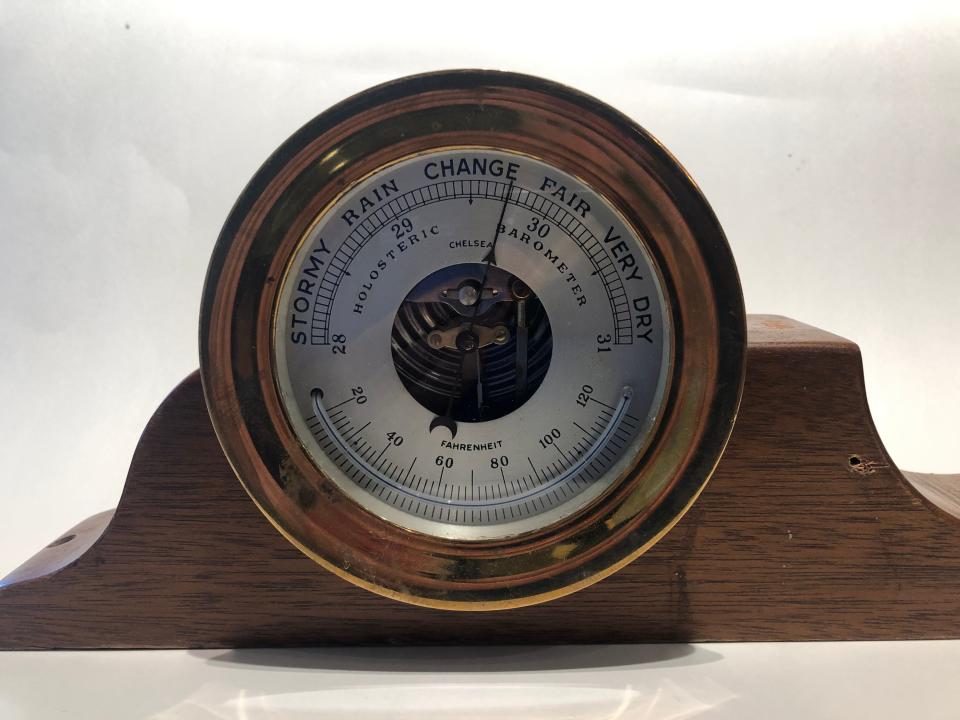Antiques: Barometers can still tell you the weather
- Oops!Something went wrong.Please try again later.
I don't know about you, but I've been a regular watcher of the local TV news for decades. The news and sports are well and good, but the weather forecast is always the main event. When the temps start to cross into three digits, the message is loud and clear.
What's a little more muddy are the dew point and barometric pressure readings. What exactly is a dew point anyway? It's kind of like one of those weird baseball statistics that announcers are always talking about but nobody else knows what they mean. Anyway, let's forget about dew points for now so we can focus on barometric pressure and specifically, the instrument that measures it: the barometer.
What I know — or think I know - about barometric pressure is that it's a fairly reliable means of forecasting short-term changes in weather. High atmospheric pressure is a mark of good weather, while falling or low pressure portends a storm. Up until the current age of satellite tracking and micro-measuring of the world's atmospheric health, such information was invaluable to farmers, mariners and anyone else whose livelihood came from the out-of-doors.
What's remarkable is that the first barometer was conceived way back in 1643 by an Italian inventor and pupil of Galileo. This observant fellow with the mouthful name of Evangelista Torricelli noticed that a measured volume of the element mercury would change from day-to-day without any obvious reason why. After considerable experimentation, he came to realize why, and the mercury barometer was born.

What a mercury barometer does is measure the downward pressure of gravity on elements in the air. When the air is dense with moisture, more pressure is exerted, and the mercury level is reduced. When the air is warmer and lighter, gravity has relatively less effect, and mercury rises. The first stick barometer, not so different than those made today, was basically a glass tube sealed at the top and open at the bottom to a small pool of mercury. On nice sunny days, the mercury would be drawn up the tube to give indication of low atmospheric pressure. On stormy days, increased pressure would squash the mercury and give ship captains warning to set sail another time.
For some 200 years after Torricelli's invention, mercury barometers were fairly common to laboratories and ships, but their high cost kept them from widespread distribution. However, they began to appear in English households around the mid-19th century, and especially so when the dial barometer came into being.
Rather than a thermometer-like stick, a clock-like dial made barometer reading easier. In 1840, the category was further enhanced with the introduction of an aneroid barometer that utilized a vacuum tube rather than mercury. While not as accurate as the mercury type, aneroid barometers proved safer and more portable than their predecessors and thus captured a significant market share.
Today's barometers are mostly digital gadgets that do the job, but hold little interest to the collector or decorator. In contrast, pre-techno instruments were often things of beauty, utilizing exotic woods and fancy dials. They're not scarce — indeed, there were some 2,000 barometer makers in England alone during the heyday of the British empire — but their glass components make them fragile, and mercury is now a restricted substance. Nonetheless, early barometers are beautiful instruments to behold and can still give indication of weather if you don't want to watch the news ... or look out the window.
Mike Rivkin and his wife, Linda, are longtime residents of Rancho Mirage. For many years, he was an award-winning catalogue publisher and has authored seven books, along with countless articles. Now, he's the owner of Antique Galleries of Palm Springs. His antiques column appears Sundays in The Desert Sun. Want to send Mike a question about antiques? Drop him a line at info@silverfishpress.com
This article originally appeared on Palm Springs Desert Sun: Antiques: Barometers can still tell you the weather

